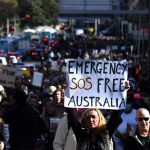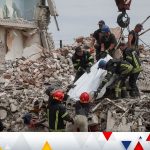As the number of dead continues to rise, the febrile guessing game of who was behind the attack gathers momentum.
No group, or state has claimed responsibility and that may very well remain the case – though there is no shortage of potential candidates.
Inside Iran, some analysts have already pointed the finger at Israel.
The attack comes the day after a top Hamas official was killed in a strike in southern Beirut.
Whilst the assassination in Lebanon appears very much to be the work of Israeli special forces, the attack in Kerman appears to be very different.
Mass casualty blasts at a commemoration for Iran’s former top military general Qassim Suleimani do not fit with Israel’s modus operandi – despite the fact that tensions between the two countries are in danger of escalating into a full scale conflict.
Read more:
Are Israel and Hezbollah heading for war?
Sky News witnesses chaos of Israeli drone strike
Israel-Gaza latest: Hezbollah leader warns Israel in speech as fears of all-out war grow after Hamas leader killed
‘At least 103 killed’ in explosions near tomb of Iranian Guards commander Qassem Soleimani during ceremony
Japan plane crash: Small coastguard jet ‘wasn’t cleared for take-off’ at time of collision
Israel does though target Iranian proxies and military figures – on Monday, an air strike killed a senior commander of Iran’s revolutionary guard in Syria.
The explosions that have killed more than a hundred at the cemetery, on the anniversary of Suleimani’s assassination by a US air strike, seem to be of a different category and are most likely the work of a non-state actor. Again it needs stressing that these are early days.
The repressive regime in Iran has for years tried to contain counter revolutionary forces and has created many enemies – not just at the state level.
Senior officials have called the blasts a “terroristic attack”.
Judging by the scale of the explosions the bombing had a level of sophistication, but it does not appear to be beyond the skill sets of many groups with operations inside the country.
Please use Chrome browser for a more accessible video player
As well as exiles – dating back to the upheaval of the 1979 Islamic Revolution – there are militant organisations in Iran who have the capability and ideological zeal to carry out an act of mass slaughter.
Sunni extremist groups – such as the Islamic State terror network – have used mass casualty bombings in the past as part of their extremist agenda.
Be the first to get Breaking News
Install the Sky News app for free
Iran has also seen mass protests in recent years – the uprising over the death of Mahsa Amini in 2022 saw widespread dissent across the country.






















